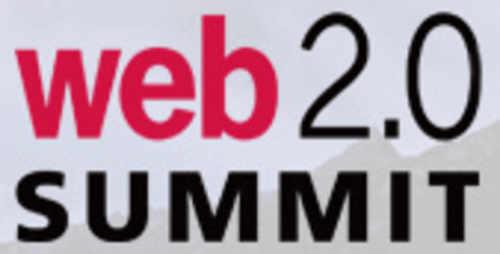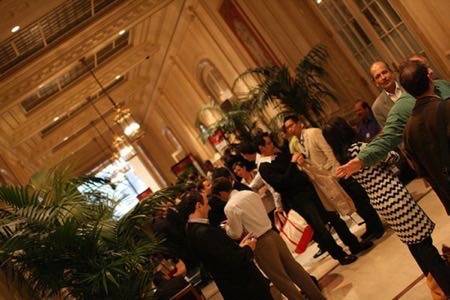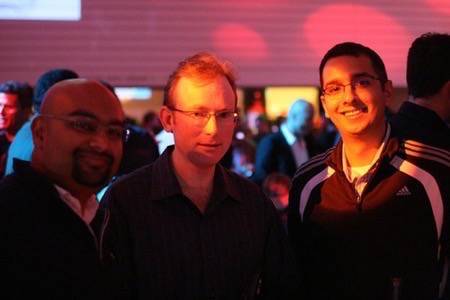Last week I attended the Web 2.0 Summit in San Francisco. This is the third year running I’ve attended – I went to the 2005 Web 2.0 Conference in October 2005, the 2006 Web 2.0 Summit in November 2006 (it was re-named the “Summit” at that point and took on a more business focus), the 2007 Web 2.0 Expo in April 2007 (more developer focused), and now the 2007 Web 2.0 Summit. Each time I’ve written a round-up (see links above), a high level look at how the events panned out.

For some reason, the 2007 Web 2.0 Summit has been harder for me to analyze than the previous 3 events. I think it’s partly because I spent less time this year in the sessions and workshops – this time I roamed around the conference center and did lots of meetings. But also it was difficult to identify an over-riding theme to this conference.
Web 2.0 Conferences 2005-06
To quickly re-cap my thoughts on the previous conferences:
- The 2004 conference, which I attended virtually, was the awakening of a new Web era. Tim O’Reilly and his team defined this as Web 2.0.
- The 2005 conference was all about the excitement of new web startups making an impact on the Internet again, for the first time since the dot com era. At the same time people were wary about how the dot com era ended, so it wasn’t the “irrational exuberance” of the previous era. I termed the mood at this event “cautious optimism and cynical buzz”.
- The 2006 conference was re-named Web 2.0 Summit and had a much bigger business focus than the previous year – I noted that “the crowd was overwhelmingly from the media and business worlds.” I also wrote that the 2006 conference was less cutting edge and lacked a creative vibe. However there was an over-riding theme to it: Web technologies were maturing. Things like Amazon’s web services initiatives, desktop/web integration, big media using the Web, and more.
- The Web 2.0 Expo in April 2007 was a lot bigger than the previous two, in terms of audience. It also had the developer and designer crowd in attendance, which helped bring some of the excitement back. The Expo Hall, teeming with startups and big tech companies alike, was the highlight. My over-riding impression was: Web 2.0 goes mainstream.
So there has been a progression over the past couple of years:
- Oct ’04: Web 2.0 is Born
- Oct ’05: Web 2.0 Tips (a.k.a. “cautious optimism and cynical buzz”)
- Nov ’06: Web 2.0 Matures
- Apr ’06: Web 2.0 Goes Mainstream
Reviewing the 2007 Web 2.0 Summit
And now we come to the 2007 Web 2.0 Summit — but this one is harder to to define. For a start, the cutting edge was even further away from the Summit than it was in 2006. The main themes that I picked up during this conference were:
- Social networking (especially Facebook); and
- The iPhone – which was seemingly carried by at least 1 out of every 2 conference participants.
Two interesting trends to be sure, but not the cutting edge of web technology.
The hallways were where the action was, as usual

However, one innovative new product type did make an appearance later in the conference: semantic apps. Twine announced itself during the Summit, and we saw on stage two startups that have been in varying stages of stealth for the past year or so: Freeweb and Powerset. So it was good to see semantic apps ‘bubbling up’ (obligatory use of the word ‘bubble’, just for Josh Kopelman).
Something was missing in the Web 2.0 Summit in 2007. The excitement factor wasn’t quite there. Content-wise, discussing Facebook’s valuation and the latest AT&T regulations weren’t very interesting from a technology perspective. Marc Canter did his best to liven things up, asking both Facebook and MySpace’s leaders to open up their social network properties. But even Marc couldn’t elicit meaningful responses from either Facebook CEO Mark Zuckerberg (who frankly looked like a young deer trapped in headlights) or the Batman and Robin big media duo of Rupert Murdoch and Chris DeWolfe.
As for the social activity at the Web 2.0 Summit, it too didn’t quite register on the excitement meter. Last year we got Lou Reed, somewhat grizzled at how fate (or his AOL kung-fu buddy Jonathan Miller) had reduced him to performing to rich Internet folks. OK, Lou sold out – but it was awesome! This year however there was no Jonathan Miller to save the day. Indeed the main party wasn’t even hosted by Web 2.0 Summit. It was by MySpace and it basically threw together two different worlds: awkward looking geeks mixing with far-too-hip media people.
Who let these geeks in? At the MySpace party, from left to right: Prashant Agarwal, Richard MacManus, Sean Ammirati

Conclusion: Steady As She Goes
After much earnest reflection, I think this year’s Web 2.0 Summit can be described as: Steady As She Goes. Nothing much had changed from last year’s Summit – even Tim O’Reilly’s attire of brown trousers/jacket and scratchy beard was the same as last year. No, this Web 2.0 thing is here to stay for a couple more years yet – Mary Meeker’s data and charts still show web 2.0 in the black, John Battelle’s questions are still incisive, Tim O’Reilly is still at the top of his analytical game (web 2.0 and financial markets was his new theme this year). It’s steady as she goes.
There was a hint of disruption with the Semantic Apps startups, muscling onto the scene with their talk of “web 3.0”. But in the end, it wasn’t enough to usurp the defining question of this conference: when will Facebook “bring in a grown-up”? (which Battelle asked Zuckerberg at the end of their session).
Hey, perhaps next year we can get Jack White and The Raconteurs to perform at the event?
Photos: Brian Solis










